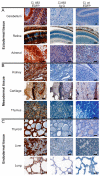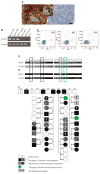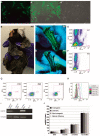Generation and Breeding of EGFP-Transgenic Marmoset Monkeys: Cell Chimerism and Implications for Disease Modeling
- PMID: 33673402
- PMCID: PMC7996964
- DOI: 10.3390/cells10030505
Generation and Breeding of EGFP-Transgenic Marmoset Monkeys: Cell Chimerism and Implications for Disease Modeling
Abstract
Genetic modification of non-human primates (NHP) paves the way for realistic disease models. The common marmoset is a NHP species increasingly used in biomedical research. Despite the invention of RNA-guided nucleases, one strategy for protein overexpression in NHP is still lentiviral transduction. We generated three male and one female enhanced green fluorescent protein (EGFP)-transgenic founder marmosets via lentiviral transduction of natural preimplantation embryos. All founders accomplished germline transmission of the transgene by natural mating, yielding 20 transgenic offspring together (in total, 45 pups; 44% transgenic). This demonstrates that the transgenic gametes are capable of natural fertilization even when in competition with wildtype gametes. Importantly, 90% of the transgenic offspring showed transgene silencing, which is in sharp contrast to rodents, where the identical transgene facilitated robust EGFP expression. Furthermore, we consistently discovered somatic, but so far, no germ cell chimerism in mixed wildtype/transgenic litters. Somatic cell chimerism resulted in false-positive genotyping of the respective wildtype littermates. For the discrimination of transgenic from transgene-chimeric animals by polymerase chain reaction on skin samples, a chimeric cell depletion protocol was established. In summary, it is possible to establish a cohort of genetically modified marmosets by natural mating, but specific requirements including careful promoter selection are essential.
Keywords: chimerism; embryo; genetic modification; germ cell; germline transmission; hematopoietic stem cell; marmoset monkey; non-human primate; transgenesis.
Conflict of interest statement
The authors declare no conflict of interest.
Figures






Similar articles
-
Generation of transgenic non-human primates with germline transmission.Nature. 2009 May 28;459(7246):523-7. doi: 10.1038/nature08090. Nature. 2009. PMID: 19478777
-
Germ-line transmission of lentiviral PGK-EGFP integrants in transgenic cattle: new perspectives for experimental embryology.Transgenic Res. 2010 Aug;19(4):549-56. doi: 10.1007/s11248-009-9333-5. Epub 2009 Oct 28. Transgenic Res. 2010. PMID: 19862638 Clinical Trial.
-
Generation of transgenic marmosets using a tetracyclin-inducible transgene expression system as a neurodegenerative disease model.Biol Reprod. 2017 Nov 1;97(5):772-780. doi: 10.1093/biolre/iox129. Biol Reprod. 2017. PMID: 29045563
-
"What's wrong with my monkey?" Ethical perspectives on germline transgenesis in marmosets.Transgenic Res. 2010 Apr;19(2):181-6. doi: 10.1007/s11248-009-9316-6. Epub 2009 Aug 19. Transgenic Res. 2010. PMID: 19690974 Review.
-
Assisted Reproductive Techniques and Genetic Manipulation in the Common Marmoset.ILAR J. 2020 Dec 31;61(2-3):286-303. doi: 10.1093/ilar/ilab002. ILAR J. 2020. PMID: 33693670 Free PMC article. Review.
Cited by
-
Generation of a tyrosine hydroxylase-2A-Cre knockin non-human primate model by homology-directed-repair-biased CRISPR genome editing.Cell Rep Methods. 2023 Sep 25;3(9):100590. doi: 10.1016/j.crmeth.2023.100590. Epub 2023 Sep 14. Cell Rep Methods. 2023. PMID: 37714158 Free PMC article.
-
Performance of Marmoset Monkeys as Embryo Donors Is Reflected by Different Stress-Related Parameters.Animals (Basel). 2022 Sep 14;12(18):2414. doi: 10.3390/ani12182414. Animals (Basel). 2022. PMID: 36139275 Free PMC article.
-
The use of alfaxalone for short-term anesthesia can confound serum progesterone measurements in the common marmoset: a case report.Primate Biol. 2022 Jul 27;9(2):23-28. doi: 10.5194/pb-9-23-2022. eCollection 2022. Primate Biol. 2022. PMID: 36034474 Free PMC article.
-
Flexible auditory training, psychophysics, and enrichment of common marmosets with an automated, touchscreen-based system.Nat Commun. 2022 Mar 28;13(1):1648. doi: 10.1038/s41467-022-29185-9. Nat Commun. 2022. PMID: 35347139 Free PMC article.
-
Non-human primate: the new frontier model of female reproductive engineering.Front Bioeng Biotechnol. 2025 Mar 28;13:1536750. doi: 10.3389/fbioe.2025.1536750. eCollection 2025. Front Bioeng Biotechnol. 2025. PMID: 40242357 Free PMC article. Review.
References
Publication types
MeSH terms
Substances
Grants and funding
LinkOut - more resources
Full Text Sources
Other Literature Sources
Research Materials

